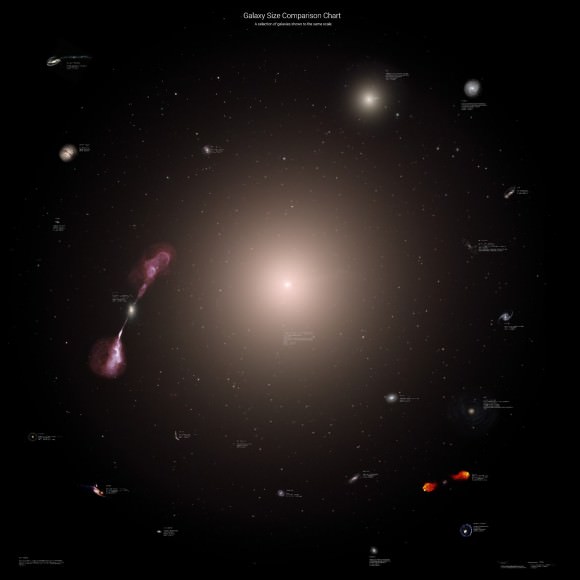I’m going to refrain from the initial response that comes to mind… actually, no I won’t — they’re really, really, really big!!!!
</Kermit arms>
Ok, now that that’s out of the way check out this graphic by Arecibo astrophysicist Rhys Taylor, which neatly illustrates the relative sizes of 25 selected galaxies using images made from NASA and ESA observation missions… including a rendering of our own surprisingly mundane Milky Way at the center for comparison. (Warning: this chart may adversely affect any feelings of bigness you may have once held dear.) According to Taylor on his personal blog, Physicists of the Caribbean (because he works had worked at the Arecibo Observatory in Puerto Rico) “Type in ‘asteroid sizes’ into Google and you’ll quickly find a bunch of images comparing various asteroids, putting them all next to each at the same scale. The same goes for planets and stars. Yet the results for galaxies are useless. Not only do you not get any size comparisons, but scroll down even just a page and you get images of smartphones, for crying out loud.” So to remedy that marked dearth of galactic comparisons, Taylor made his own. Which, if you share my personal aesthetics, you’ll agree is quite nicely done.
“I tried to get a nice selection of well-known, interesting objects,” Taylor explains. “I was also a little limited in that I needed high-resolution images which completely mapped the full extent of each object… still, I think the final selection has a decent mix, and I reckon it was a productive use of a Saturday.” And even with the dramatic comparisons above, Taylor wasn’t able to accurately portray to scale one of the biggest — if not the biggest — galaxies in the observable universe: IC 1101.
For an idea of how we measure up to that behemoth, he made this graphic:

That big bright blur in the center? That’s IC 1101, the largest known galaxy — in this instance created by scaling up an image of M87, another supersized elliptical galaxy that just happens to be considerably closer to our own (and thus has had clearer images taken of it.) But the size is right — IC 1101 is gargantuan.
At an estimated 5.5 million light-years wide, over 50 Milky Ways could fit across it! And considering it takes our Solar System about 225 million years to complete a single revolution around the Milky Way… well… yeah. Galaxies are big. Really, really, really, really big!
</Kermit arms>
Now if you’ll pardon me, I need to go stop my head from spinning… Read this and more on Rhys Taylor’s blog here, and add Rhys to your awesome astronomy Google+ circles here. And you can find out more about IC 1101 in the video below from Tony Darnell, aka DeepAstronomy:

